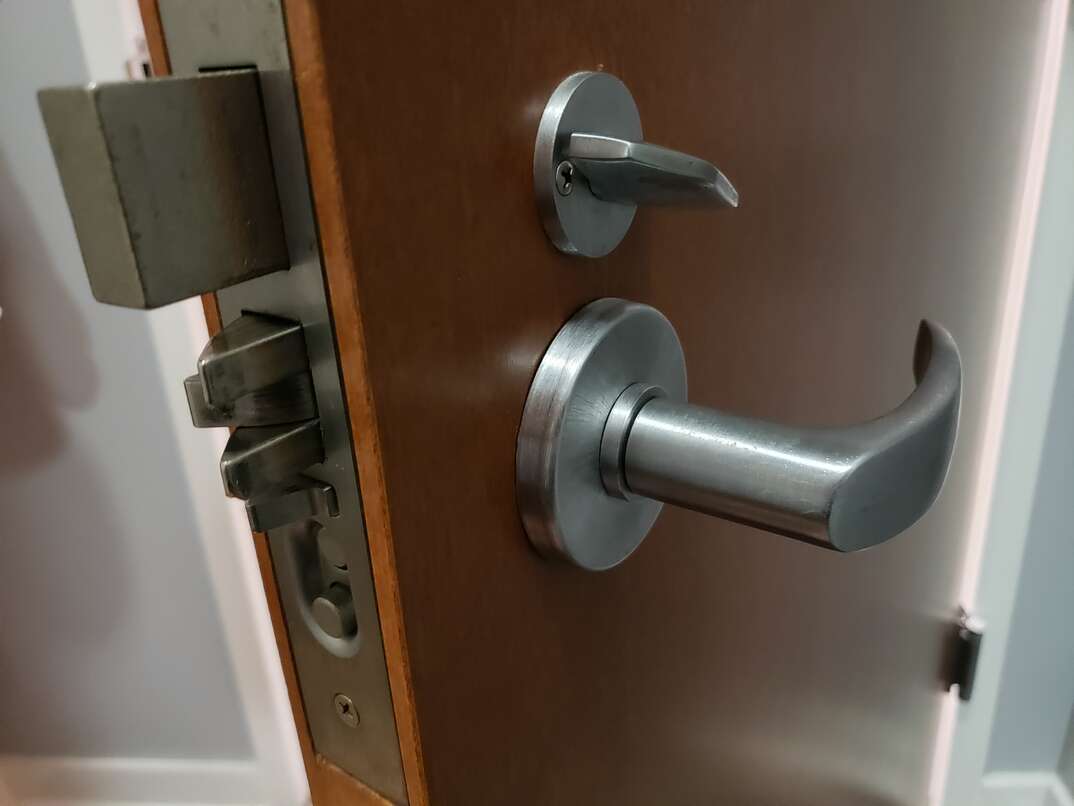What's a Mortise Lock and How Do You Use One?

Have you ever experienced that heart-stopping moment when you take out the trash, only to find your front door has blown shut behind you? With a mortise lock, this is far less likely to happen.
Read More Home Improvement Articles
Plus, you’ll have peace of mind knowing that your strong lock is a burglar’s worst nightmare.
What Is a Mortise Lock?
Mortise locks are the tried and tested standard for hard-wearing, secure locks. It’s essentially a large, square lock system that fits inside your door. “Mortise” is another name for the chiseled gap that you have to cut into the door to fit the lock system.
There’s usually a handle or lever that controls the spring latch to keep the door closed, and there’s a separate locking bolt that you lock with a key. The latch and bolt slide out of the door and fit into the strike plate of the door jamb. Instead of installing the lock on the outside of the door, the locking bolt and latch fit into a purpose-cut hole.
If you’ve ever locked an external door with a key that also features a lever handle to close the door, you’ve likely used a mortise lock. To use it, you turn the lever downward, which pulls the spring latch into the door to open it. To release the spring latch, let go of the lever. To lock the door, close it and then turn the key in the lock in the direction of the door jamb; this activates the locking bolt.
What Are the Benefits of Having a Mortise Lock?
Safe and Durable
If you look at any old-fashioned door, chances are you’ll find it locks with a mortise lock. They’ve existed for decades and are still relied on today. The mortise lock is by far one of the most durable locks available as it can withstand constant opening, closing and locking in high-traffic areas. This is due to the large locking system, which is longer and thicker than small cylinder-type locks.
Harder to Pick
Mortise locks feature an independent latch and bolt, making it tough work for an amateur lock picker to break compared with other kinds of locks. It also recedes into the door with the bolt sliding across into the door jamb, rather than fixing on the outside part of the door, which makes it more difficult to break into.
Easy to Replace
Mortise locks are made from many different parts — you can replace the lever, bolt, latch and mortise box separately. For example, if the lever breaks, you can swap it out for a new one without replacing the entire unit.
More Related Articles:
- 8 Benefits of Installing Smart Locks
- Here’s How Much a Locksmith Charges for 5 of the Most Common Services
- Lose Your Keys Often? Here's How to Prevent Lockouts
- Installing a New Deadbolt? Here's Everything You Need to Know
- What Is Rekeying a Lock?
When and Where Are Mortise Locks Often Used?
Due to the strength and reliability mortise locks offer, you’ll find them in commercial buildings such as schools, hotels and hospitals, the entrances to apartment complexes and on the front doors of many homes. The lock system is large, so they fit best in thicker doors, like purpose-built exterior or old-fashioned doors.
You can fit a mortise lock on an interior or modern door, but you may need to plan ahead and ensure your door can accommodate one before you begin chiseling a hole in the wood. Some modern doors are hollow or simply weaken when a pocket is chiseled to fit a mortise lock.
How Do Cylinder Locks Compare to Mortise Locks?
Cylinder locks are quite common for interior doors. They’re much easier to install — in fact, an amateur could fit a cylinder lock within an hour with the right tools.
Also referred to as "bored cylindrical locks," two holes are bored into the door — one through the door and another into the edge of the door that contacts the door jamb. A cylinder lock uses one latch to open, close and lock the door, with a key on one or both sides. The key must be turned in the lock for the door to open, unlike a mortise lock.
Although they’re a more affordable alternative to a mortise lock, they’re far easier to break into and offer less security.
Can I Replace a Cylinder Lock With a Mortise Lock?
In some cases, you may be able to swap out your cylinder lock for a mortise lock, but check your door first — there may be gaps left over from the older circular boring holes. In this case, it’s best to contact a professional who may be able to offer an alternative solution.
Elocal Editorial Content is for educational and entertainment purposes only. Editorial Content should not be used as a substitute for advice from a licensed professional in your state reviewing your issue. Systems, equipment, issues and circumstances vary. Follow the manufacturer's safety precautions. The opinions, beliefs and viewpoints expressed by the eLocal Editorial Team and other third-party content providers do not necessarily reflect the opinions, beliefs and viewpoints of eLocal or its affiliate companies. Use of the Blog is subject to the
Website Terms and Conditions.The eLocal Editorial Team operates independently of eLocal USA's marketing and sales decisions.



